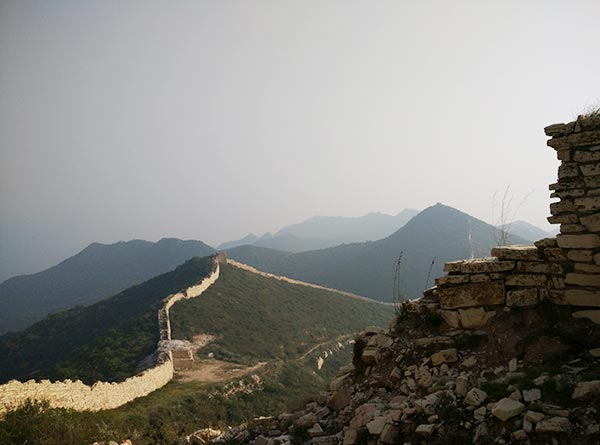Fresh bricks in old wall
Updated: 2015-10-20 07:17
By Wang Kaihao(China Daily)
|
||||||||
 |
|
The Great Wall in Hebei province is facing challenges of time and neglect, but local authorities are trying to change the situation. [Photo by Wang Kaihao/China Daily] |
Wang's team receives only 30,000 yuan ($4,700) a year to walk the Wall and gather data.
He wants to establish more county-level offices to supervise parts of the Wall and have institutions such as Li's museum to assist them in taking care of remains of the Wall that fell to natural decay or human interference. But the limited grassroots expertise on cultural heritage protection isn't giving Wang qualified field researchers.
"Yangbian is already much luckier than most other places on the Great Wall because some were lost before we knew of them," Wang says. "The Wall is not always like Beijing's Badaling. Many parts are hidden by farmlands or countryside roads."
China promulgated a national rule to protect the Great Wall in 2006. It set a 500-meter protection zone on both sides, where construction activities are barred.
But Wang says it is impossible to isolate the Wall completely due to its close connection with Chinese people's daily lives.
"Local villagers are sometimes probably even unaware that these stones or earthen fences are part of heritage," he says.
Nevertheless, some places in Hebei now have come up with solutions. In Qinhuangdao, a seaside city about 500 km eastward of Zhangjiakou, a protection network has been set up.
"Some villagers grew grains using the Wall as a fence, and some fed sheep in the fortress," Qiao Guohua, 59, says. "They don't do that anymore."
Qiao's home village is at the base of a section of the Great Wall there. This man is among 22 rural people tasked with looking out for about 140 km of the Wall in Funing district.
They began as volunteers, but now they get paid 1,000 yuan a year for the part-time job.
- Wide support seen for nationwide smoking ban
- Treat or cheat: Chinese media exposes queer therapies on gay people
- Farmland hot spots increase air pollution
- Mentally impaired earn their bread at Nanjing bakery
- China 'will never recklessly resort to the use of force'
- Chinese look yonder for luxury goods
Most Viewed
Editor's Picks

|

|

|

|

|

|
Today's Top News
Tu first Chinese to win Nobel Prize in Medicine
Huntsman says Sino-US relationship needs common goals
Xi pledges $2 billion to help developing countries
Young people from US look forward to Xi's state visit: Survey
US to accept more refugees than planned
Li calls on State-owned firms to tap more global markets
Apple's iOS App Store suffers first major attack
Japan enacts new security laws to overturn postwar pacifism
US Weekly

|

|















